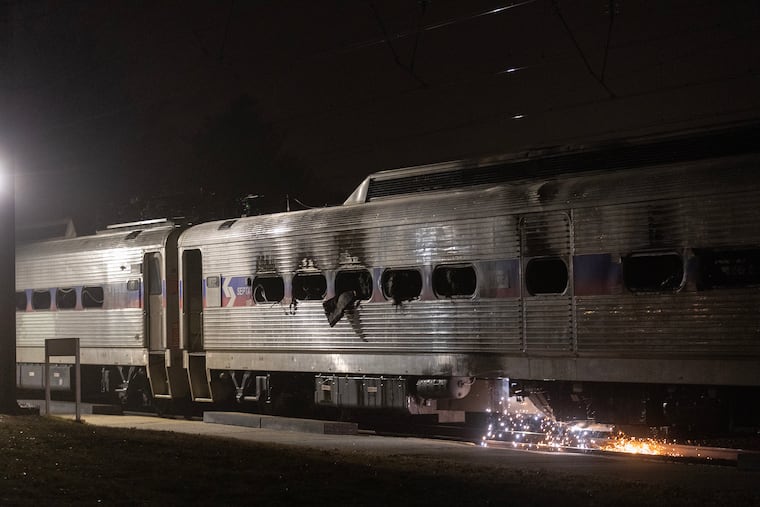Problems were reported just hours before SEPTA train fire that caused $10 million in damages, NTSB says
Less than an hour before the Feb. 6 fire in Delaware County, the engineer reported a “strong burning smell," but the train was allowed to continue, the NTSB said.

Problems were reported — including a “strong burning smell” — about a SEPTA train the same day it caught fire in Delaware County last month, causing the agency about $10 million in equipment damages, the National Transportation Safety Board said Wednesday.
The Wilmington/Newark Line train was inspected the afternoon of Feb. 6, but was allowed to continue operating, the NTSB said.
Shortly before 6 p.m. that day, the lead railcar was reported to be on fire south of the Crum Lynne Station in Ridley Park.
No injuries were reported among the 325 passengers and four crew.
The NTSB issued its preliminary report on Wednesday and said its investigation is ongoing and will focus on the source of the fire, as well as “evaluating SEPTA’s railcar inspection, maintenance, and repair process,” and SEPTA Regional Rail Operations Control Center’s “response to en route train failures.”
A spokesperson for SEPTA, citing the NTSB investigation, declined to comment.
Train 3223, which had six railcars and was traveling from West Trenton to Newark, Del., was at Bethayres Station in Huntingdon Valley about 3:50 p.m. when the engineer contacted the Regional Rail Operations Control Center and told the dispatcher that the train was sluggish and not getting up to speed, and that a fault light on the train was on, the NTSB said.
The dispatcher arranged for a mechanical maintenance team to inspect the train near SEPTA’s Roberts Yard in Philadelphia, the NTSB said. At 4:31 p.m., the team completed its inspection and contacted the superintendent of train operation to report that three of the railcars were “bad” and causing the slow acceleration of the train.
“However, the train continued to operate,” the NTSB said.
At 4:55 p.m., there was a crew change at Suburban Station.
At 5:07 p.m., when the train was at 30th Street Station, the new engineer received a call from the chief dispatcher at the control center and reported that there was a “strong burning smell” in the lead railcar, the NTSB said.
“The train still continued to operate en route,” the NTSB said.
At 5:48 p.m., as the train reached Crum Lynne Station, the engineer noticed haze behind the lead railcar, the NTSB said.
As the train departed Crum Lynne Station, the engineer saw smoke behind the lead railcar and stopped the train 638 feet south of the station, the NTSB said.
“The engineer stepped down to inspect the train and, about 5:56 p.m., reported that the lead railcar was on fire,” the NTSB said.
The crew lowered the pantograph, which was connected to the overhead power line, and moved passengers to the rear railcars of the train, the NTSB said.
When the crew established that it was safe outside the train, the crew evacuated the passengers through the rear of the train, the NTSB said.
The evacuation was reported complete at 6:22 p.m.